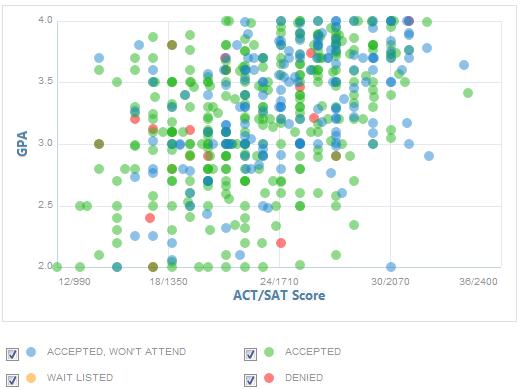If you have searched for colleges, you know the lingo: Create a balanced list of reach schools, match schools and safety/safer schools. But while the directive seems straightforward enough, figuring out a balanced list can be tougher than it seems. How can you get a true sense of your chances of admission? After all, if it were clear at the beginning of the process where you would get in, why go through the process of applying to multiple schools at all?
There is no perfect system for determining your chance of admission to any given school, but there are best practices. To figure out if a school is a reach, match or safety, we can look at a college’s recent admission history. This will give us a fairly good picture of how a college will look at the next set of applicants.
 When looking at history, the most useful data is collected by your high school. Where have past students with your GPA and test scores been admitted? If your school uses Naviance to organize the college application process, you should have access to Scattergrams that show how your GPA and scores compare to students who have applied before. Are your stats well within the range of students who have been accepted? If so, that school is probably a match for you. If you are significantly above most accepted students, it is most likely a safety. If you are below the averages of accepted students, it is a reach. One caveat to this rule: You might have very high scores. Does this mean that every school out there is a match or safety? At the very top of the selectivity scale, schools review more qualified students than they can possibly accept. They are turning away incredibly strong applicants. For this reason, when building a list, you want to think of any school that accepts only 30% or below as a reach school, regardless of how competitive an applicant you are.
When looking at history, the most useful data is collected by your high school. Where have past students with your GPA and test scores been admitted? If your school uses Naviance to organize the college application process, you should have access to Scattergrams that show how your GPA and scores compare to students who have applied before. Are your stats well within the range of students who have been accepted? If so, that school is probably a match for you. If you are significantly above most accepted students, it is most likely a safety. If you are below the averages of accepted students, it is a reach. One caveat to this rule: You might have very high scores. Does this mean that every school out there is a match or safety? At the very top of the selectivity scale, schools review more qualified students than they can possibly accept. They are turning away incredibly strong applicants. For this reason, when building a list, you want to think of any school that accepts only 30% or below as a reach school, regardless of how competitive an applicant you are.
If your high school doesn’t keep good records of who got in where, check out the averages that each college reports. To start, you should look at the most controversial (and often-reviled) piece of the admission equation: standardized test scores. These scores can be found both in the Fiske Guide (the iPad app is great!) or by looking through the College Profiles on the CollegeApps website. As you are looking, consider what scores the mid-50th percentile of admitted students tend to get. You might have heard from admissions offices that your grades and class rigor will be weighed more heavily in an admissions decision than standardized test scores, and this is usually true. So why consider scores first? As imperfect as test scores are, they are useful because they can be compared apples to apples, regardless of geography, high school, or program curriculum. Other academic measurements are more difficult to compare because of the differences at high schools nationwide. What, for example, does it mean if 90% of students accepted to a college have at least a 3.7 Grade Point Average? Is the GPA weighted? Does the GPA include electives or just academic subjects? How about your easy A from gym class?
What about a college that reports the average rank-in-class of its accepted students? For example, a college might say that 80% of accepted students come from the top 10% of their high school classes. This might give you some idea, but what if your high school doesn’t report rank in class? Also, being in the top 25% at a highly competitive high school is often considered differently by an admissions committee than being in the top 25% of a less competitive school. Again, the statistical noise makes it tricky to take away much information. In short, use scores as a short hand for where you would be in the applicant pool. Just make sure that your grades and rigor are more or less consistent with your scores. If you are scoring in the high 700s, but your GPA is a 3.0 because you haven’t worked up to your abilities, don’t count on getting into the most competitive schools in the country.
It should be noted that some students bring special qualities to a college, which would put them in a more likely category for admission than the numbers would suggest. A student might be a recruited athlete, a legacy of the school, an under-represented minority or a nationally renowned violinist. Any of these might give a student a bump. You might be one of these special cases. Still, even if you suspect that you have a leg up, build your list conservatively. You need to cover your bases to make sure that you have options. Use the numbers just like any other student to determine if a school is a reach, match or safety. You might have a better shot at getting into your reach schools, but they still should be put in the reach category.
Finally, remember that your safety schools shouldn’t just be schools you can get into, but schools you would be happy to attend. The point of including safety schools is to provide more likely options. If you are just throwing them on your list because they are “easy to get into,” you might get in, but what’s the point if you do not want to enroll at any of them? By taking the time at the beginning to find schools that you like across the selectivity spectrum, you should have excellent options regardless of how the cards are dealt at the end.

